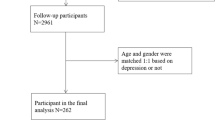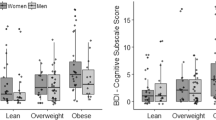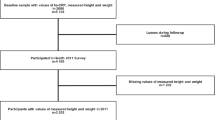Abstract
Background:
Depression has been associated with increased risk of cardiovascular disease. The inflammatory marker C-reactive protein (CRP) has also been identified as an independent predictor of short- and long-term cardiovascular disease events. Inflammation may influence the relationship between depression and cardiovascular disease.
Objective:
The objective of this study was to investigate the association between symptoms of depression and high-sensitivity CRP (hs-CRP) in an obese clinical population. We also sought to determine whether this relationship was different in men and women, given prior reports of a gender effect.
Methods:
Symptoms of depression and hs-CRP were measured in 390 participants enrolled in a weight loss intervention trial that was delivered in a primary care setting. Symptoms of depression were evaluated with the Patient Health Questionnaire-8 (PHQ-8), in which a score ⩾10 is consistent with major depression.
Results:
A total of 58 (15.2%) participants reported a PHQ-8 score ⩾10. The median (interquartile range) hs-CRP concentration was significantly higher in participants with symptoms consistent with major depression (7.7 (4.2–13) mg l−1) compared with those without depression (5.1 (3–9.7) mg l−1; P<0.01). Symptoms consistent with major depression were significantly associated with log-transformed hs-CRP concentrations in an analysis adjusted for age, gender, obesity class and other metabolic variables (P=0.04). When interaction by gender was examined, this relationship remained significant in men (P<0.01) but not in women (P=0.32).
Conclusions:
Symptoms consistent with major depression were significantly associated with hs-CRP in men only, even after adjusting for age, obesity class, metabolic variables and medications known to affect inflammation. This finding suggests that there are biologic differences between men and women that may modify the relationship between hs-CRP and depression. Further studies are needed to elucidate the biologic basis for these findings.
This is a preview of subscription content, access via your institution
Access options
Subscribe to this journal
Receive 12 print issues and online access
$259.00 per year
only $21.58 per issue
Buy this article
- Purchase on Springer Link
- Instant access to full article PDF
Prices may be subject to local taxes which are calculated during checkout

Similar content being viewed by others
References
Anda R, Williamson D, Jones D, Macera C, Eaker E, Glassman A et al. Depressed affect, hopelessness, and the risk of ischemic heart disease in a cohort of U.S. adults. Epidemiology 1993; 4: 285–294.
Barefoot JC, Schroll M . Symptoms of depression, acute myocardial infarction, and total mortality in a community sample. Circulation 1996; 93: 1976–1980.
Ferketich AK, Schwartzbaum JA, Frid DJ, Moeschberger ML . Depression as an antecedent to heart disease among women and men in NHANES I study. National Health and Nutrition Examination Survey. Arch Intern Med 2000; 160: 1261–1268.
Van der Kooy K, van Hout H, Marwijk H, Marten H, Stehouwer C, Beekman A . Depression and the risk for cardiovascular diseases: systematic review and meta-analysis. Int J Geriatr Psychiatry 2007; 22: 613–626.
Raison CL, Capuron L, Miller AH . Cytokines sing the blues: inflammation and pathogenesis of depression. Trends Immunol 2006; 27: 24–31.
Miller AH . Mechanisms of cytokine-induced behavioral changes: psychoneuroimmunology at the translational interface. Brain Behav Immun 2009; 23: 149–158.
Dowlati Y, Herrman N, Swardfager W, Liu H, Sham L, Reim EK et al. A meta-analysis of cytokines in major depression. Biol Psychiatry 2010; 67: 446–457.
Visser M, Bouter LM, McQuillan GM, Wener MH, Harris TB . Elevated C-reactive protein levels in overweight and obese adults. JAMA 1999; 282: 2131–2135.
Nguyen XM, Lane J, Smith BR, Nguyen NT . Changes in inflammatory biomarkers across weight classes in a representative US population: link between obesity and inflammation. J Gastrointest Surg 2009; 13: 1205–1212.
Park HS, Park JY, Yu R . Relationship of obesity and visceral adiposity with serum concentrations of CRP, TNF-a, and IL-6. Diabetes Res Clin Pract 2005; 69: 29–35.
Ridker PM, Cushman M, Stampfer MJ, Tracy RP, Hennekens CH . Inflammation, aspirin, and the risk of cardiovascular disease in apparently healthy men. N Engl J Med 1997; 336: 973–979.
Ridker PM, Cushman M, Stampfer MJ, Tracy RP, Hennekens CH . Plasma concentration of C-reactive protein and risk of developing peripheral vascular disease. Circulation 1998; 97: 425–428.
Koenig W, Sund M, Fröhlich M, Fischer HG, Löwel H, Döring A et al. C-reactive protein, a sensitive marker of inflammation, predicts future risk of coronary heart disease in initially healthy middle- aged men. Results from the MONICA (Monitoring Trends and Determinants in Cardiovascular Disease) Augsburg Cohort Study, 1984 to 1992. Circulation 1999; 99: 237–242.
Tracy RP, Lemaitre RN, Psaty BM, Ives DG, Evans RW, Cushman M et al. Relationship of C-reactive protein to risk of cardiovascular disease in the elderly. Results from the Cardiovascular Health Study and the Rural Health Promotion Project. Arterioscler Thromb Vasc Biol 1997; 17: 1121–1127.
Kuller LH, Tracy RP, Shaten J, Meilahn EN, for the MRFIT Research Group. Relationship of C-reactive protein and coronary heart disease in the MRFIT nested case-control study. Am J Epidemiol 1996; 144: 537–547.
Haverkate F, Thompson SG, Pyke SD, Gallimore JR, Pepys MB . Production of C-reactive protein and risk of coronary events in stable and unstable angina: European Concerted Action on Thrombosis and Disabilities Angina Pectoris Study Group. Lancet 1997; 349: 462–466.
Rifai N, Tracy RP, Ridker PM . Clinical efficacy of an automated high-sensitivity C-reactive protein assay. Clin Chem 1999; 45: 2136–2141.
Pearson TA, Mensah GA, Alexander RW . Centers for Disease Control and Prevention, American Heart Association Markers of inflammation and cardiovascular disease: application to clinical and public health practice: a statement of healthcare professions from the Centers for Disease Control and Prevention and the American Heart Association. Circulation 2003; 107: 499–511.
Danner M, Kasl SV, Abramson JL, Vaccarino V . Association between depression and elevated C-reactive protein. Psychosom Med 2003; 65: 347–356.
Ford DE, Erlinger TP . Depression and C-reactive protein in US adults: data from the Third National Health and Nutrition Examination Survey. Arch Intern Med 2004; 164: 1010–1014.
Pennix BW, Kritchevsky SB, Yaffe K, Newman AB, Simonsick EM, Rubin S et al. Inflammatory markers and depressed mood in older persons: reasons from the Health, Aging, and Body Composition study. Biol Psychiatry 2003; 54: 566–572.
Howren MB, Lamkin DM, Suls J . Association of depression with C-reactive protein, IL-1, and IL-6: a meta-analysis. Psychosom Med 2009; 71: 171–186.
Elovainio M, Aalto AM, Kivimäki M, Pirkola S, Sundvall J, Lönnqvist J et al. Depression and C-reactive protein: population-based Health 2000 study. Psychosom Med 2009; 71: 423–430.
Bremmer MA, Beekman AT, Deeg DJ, Pennix BW, Dik MG, Hack CE et al. Inflammatory markers in late-life depression: results from a population-based study. J Affect Disord 2008; 106: 249–255.
Hemingway H, Marmot M . Psychosocial factors in the etiology and prognosis of coronary heart disease: systematic review of prospective cohort studies. BMJ 1999; 318: 1460–1467.
Janszky I, Lekander M, Blom M, Georgiades A, Ahnve S . Self-rated health and vital exhaustion, but not depression, is related to inflammation in women with coronary heart disease. Brain Behav Immun 2005; 19: 555–563.
Ladwig KH, Marten-Mittag B, Lowel H, Doring A, Koenig W . Influence of depressive mood on the association of CRP and obesity in 3205 middle aged healthy men. Brain Behav Immun 2003; 17: 268–275.
Whooley MA, Caska CM, Hendrickson BE, Rourke MA, Ho J, Ali S . Depression and inflammation in patients with coronary artery disease: findings from the Heart and Soul study. Biol Psychiatry 2007; 62: 314–320.
Wadden TA, Volger S, Sarwer DB, Vetter ML, Tsai AG, Berkowitz RI et al. A two-year randomized trial of obesity treatment in primary care practice. N Engl J Med 2011; 365: 1969–1979.
Expert Panel on Detection and Treatment of High Blood Cholesterol in Adults. Executive summary of the third report of the National Cholesterol Education Program (NCEP) expert panel on the detection, evaluation, and treatment of high blood cholesterol in adults (Adult Treatment Panel III). JAMA 2001; 285: 2486–2497.
Martin RF . General Deming regression for estimating systematic bias and its confidence interval in method comparison studies. Clin Chem 2000; 46: 100–104.
Kroenke K, Strine TW, Spitzer RL, Williams JB, Berry JT, Mokdad AH . The PHQ-8 as a measure of current depression in the general population. J Affect Disord 2009; 114: 163–173.
American Psychiatric Association. Diagnostic and Statistical Manual of Mental Disorders 4th edn. American Psychiatric Association: Washington, DC, USA, 1994.
Kroenke K, Spitzer RL, Williams JBW . The PHQ-9: validity of a brief depression severity measure. J Gen Intern Med 2001; 16: 606–613.
World Health Organization. Physical status: the use and interpretation of anthropometry. Report of a WHO expert committee. World Health Organ Tech Rep Ser 1995; 854: 1–452.
Lobo RA . Metabolic syndrome after menopause and the role of hormones. Maturitas 2008; 60: 10–18.
Ma Y, Chiriboga DE, Pagoto SL, Rosal MC, Li W, Merriam PA et al. Association between depression and C-reactive protein. Cardiol Res Pract 2011. e-pub ahead of print 22 December 2010 doi:10.4061/2011/286509.
Evans EM, Van Pelt RE, Binder EF, Williams DB, Ehsani AA, Kohrt WM . Effects of HRT and exercise training on insulin action, glucose tolerance, and body composition of older women. J Appl Physiol 2001; 90: 2033–2040.
Halder I, Marsland AL, Cheong J, Muldoon MF, Ferrell RE, Manuck SB . Polymorphisms in the CRP gene moderate an association between depressive symptoms and circulating levels of C-reactive protein. Brain Behav Immun 2010; 24: 160–167.
Douglas KM, Taylor AJ, O’Malley PG . Association between depression and C-reactive protein in a screening population. Psychosom Med 2004; 66: 679–683.
Dixon JB, Hayden MJ, Lambert GW, Dawood T, Anderson ML, Dixon ME ., ML, ME et al. Raised CRP levels in obese patients: symptoms of depression have an independent positive association. Obesity 2008; 16: 2010–2015.
Acknowledgements
This research was supported by grants from the National Heart, Lung and Blood Institute (U01-HL087072) and National Institute of Diabetes and Digestive and Kidney Diseases (K24-DK065018). We thank Jeffrey Lavenberg, MS, for his assistance with the statistical analysis.
This article is published as part of a supplement, sponsored by the Center for Weight and Eating Disorders—University of Pennsylvania.
Author information
Authors and Affiliations
Consortia
Corresponding author
Ethics declarations
Competing interests
TAW serves on the advisory boards of Novo Nordisk and Orexigen Therapeutics, which are developing weight loss medications, as well as of Alere and the Cardiometabolic Support Network, both of which provide behavioral weight loss programs. TAW has also served as a consultant for Boehringer Ingelheim and has received grant support from the National Institutes of Health (NIH/NIDDK and NIH/NHLBI). DBS discloses relationships with the following companies: Allergan, BariMD, BaroNova, Enteromedics and Galderma. DBS has also received grant support from the National Institutes of Health (NIH). The other authors declare no conflict of interest.
Appendix
Appendix
POWER-UP Research Group: Investigators and Research Coordinators
Academic investigators at the Perelman School of Medicine at the University of Pennsylvania were Thomas A Wadden, PhD (principal investigator), David B Sarwer, PhD (co-principal investigator), Robert I Berkowitz, MD, Jesse Chittams, MS, Lisa Diewald, MS, RD, Shiriki Kumanyika, PhD, Renee Moore, PhD, Kathryn Schmitz, PhD, Adam G Tsai, MD, MSCE, Marion Vetter, MD and Sheri Volger, MS, RD.
Research coordinators at the University of Pennsylvania were Caroline H Moran, BA, Jeffrey Derbas, BS, Megan Dougherty, BS, Zahra Khan, BA, Jeffrey Lavenberg, MA, Eva Panigrahi, MA, Joanna Evans, BA, Ilana Schriftman, BA, Dana Tioxon, Victoria Webb, BA and Catherine Williams-Smith, BS.
POWER-UP Research Group: Participating Sites and Clinical Investigators
PennCare–Bala Cynwyd Medical Associates: Ronald Barg, MD, Nelima Kute, MD, David Lush, MD, Celeste Mruk, MD, Charles Orellana, MD and Gail Rudnitsky, MD (primary care providers); Angela Monroe (lifestyle coach); Lisa Anderson (practice administrator).
PennCare–Internal Medicine Associates of Delaware County: David E Eberly, MD, Albert H Fink Jr MD, Kathleen Malone, CRNP, Peter B Nonack, MD, Daniel Soffer, MD, John N Thurman, MD and Marc J Wertheimer, MD (primary care providers); Barbara Jean Shovlin, Lanisha Johnson (lifestyle coaches); Jill Esrey (practice administrator).
PennCare–Internal Medicine Mayfair: Jeffrey Heit, MD, Barbara C Joebstl, MD and Oana Vlad, MD (primary care providers); Rose Schneider, Tammi Brandley (lifestyle coaches); Linda Jelinski (practice administrator).
Penn Presbyterian Medical Associates: Joel Griska, MD, Karen J Nichols, MD, Edward G Reis, MD, James W Shepard, MD and Doris Davis-Whitely, PA (primary care providers); Dana Tioxon (lifestyle coach); Charin Sturgis (practice administrator).
PennCare–University City Family Medicine: Katherine Fleming, CRNP, Dana B Greenblatt, MD, Lisa Schaffer, DO, Tamara Welch, MD and Melissa Rosato, MD (primary care providers); Eugonda Butts, Marta Ortiz, Marysa Nieves and Alethea White (lifestyle coach); Cassandra Bullard (practice administrator).
PennCare–West Chester Family Practice: Jennifer DiMedio, CRNP, Melanie Ice, DO, Brandt Loev, DO, John S Potts, DO and Christine Tressel, DO (primary care providers); Iris Perez, Penny Rancy, and Dianne Rittenhouse (lifestyle coaches); Joanne Colligan (practice administrator).
Rights and permissions
About this article
Cite this article
Vetter, M., Wadden, T., Vinnard, C. et al. Gender differences in the relationship between symptoms of depression and high-sensitivity CRP. Int J Obes 37 (Suppl 1), S38–S43 (2013). https://doi.org/10.1038/ijo.2013.95
Published:
Issue Date:
DOI: https://doi.org/10.1038/ijo.2013.95
Keywords
This article is cited by
-
Psychiatric symptoms are not associated with circulating CRP concentrations after controlling for medical, social, and demographic factors
Translational Psychiatry (2022)
-
Obesity induced by Borna disease virus in rats: key roles of hypothalamic fast-acting neurotransmitters and inflammatory infiltrates
Brain Structure and Function (2020)
-
Sex Difference in the Association between High-sensitivity C-reactive Protein and Depression: The 2016 Korea National Health and Nutrition Examination Survey
Scientific Reports (2019)
-
Stress, sex hormones, inflammation, and major depressive disorder: Extending Social Signal Transduction Theory of Depression to account for sex differences in mood disorders
Psychopharmacology (2019)
-
Metabolic syndrome and depressive symptoms among rural Northeast general population in China
BMC Public Health (2017)



